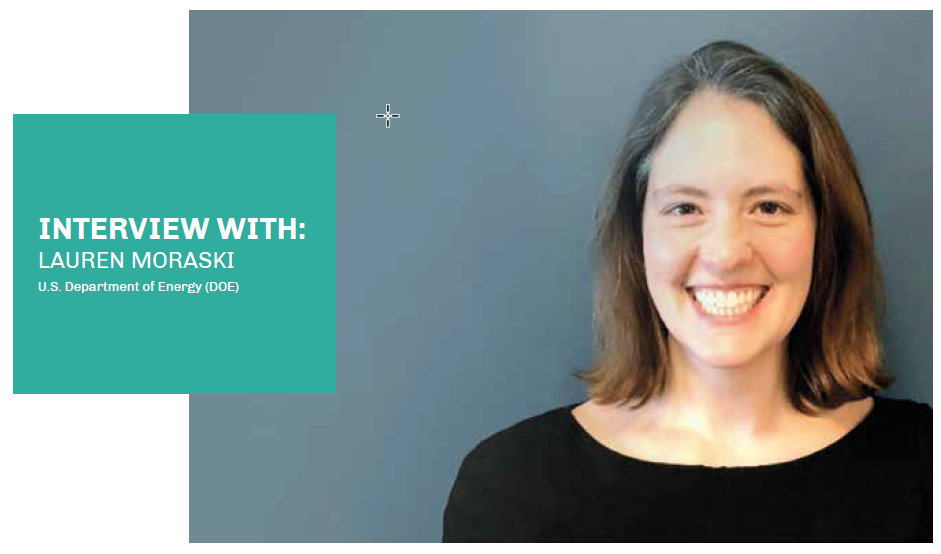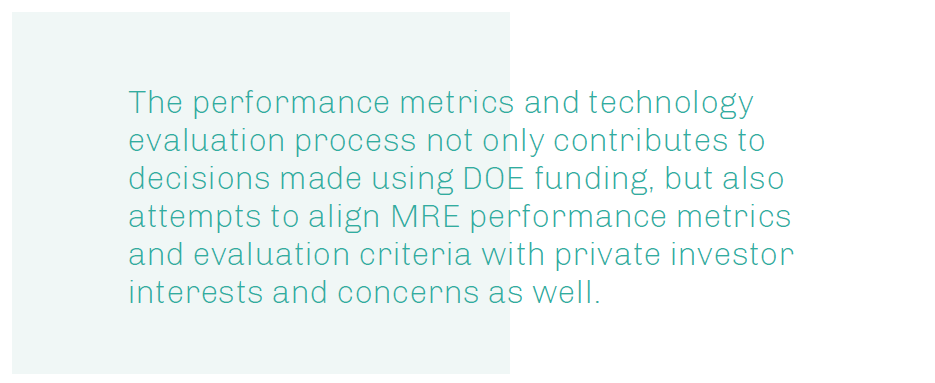Interview with U.S Dept. of Energy (DOE)
|
U.S DEPARTMENT OF ENERGY (DOE) Lauren Moraski Ruedy is a Technology Manager in the Water Power Technologies Office at the U.S. Department of Energy. Her focus is on Marine Renewable Energy and she manages research and development projects pertaining to materials development, performance metrics, and in-water device testing. Prior to joining the Department of Energy in 2017, Lauren worked as a civilian Naval Architect for the U.S Navy at the Naval Surface Warfare Center Carderock Division. Lauren holds a Bachelor of Science in Engineering in Naval Architecture and Marine Engineering from the University of Michigan and a Master of Science in Engineering Management from George Washington University. |
 |
OES: The use of a formalized technology evaluation or stage-gate process is in general seen as a promising tool for structured decision-making and controlling project quality. From your experience, what do you consider the major benefits of the application of this process to ocean energy?
LMR: The use of a formalized technology evaluation process as applied to ocean energy has benefits for
both technology developers and funding organizations. A formal process enables consistent, fair evaluation of requests for funding; it ensures devices and/or projects are evaluated objectively against the same set of criteria, rather than subjectively against the quality of applications received during a particular round of solicitations. A well done technology evaluation process though should also reflect the logical progression for technology development and use criteria that measures meaningful progress.
OES: How do stage gate processes help the sector to achieve a stamp of approval needed to alleviate investor concerns?
LMR: At the Water Power Technologies Office (WPTO) within the U.S. Department of Energy (DOE), we focus on funding early-stage research and development efforts whose successes can be measured against an agreed-upon set of metrics; these consistently measured successes will then eventually enable the transition from federal funding to private investment and self-sufficiency.
To ensure performance metrics are in alignment with what is used by developers and potential private
investors within the sector, DOE issued a Request For Information (RFI) on existing performance metrics within the Marine Renewable Energy (MRE) industry. We focused on four response areas:
- the performance metrics identified within the document titled “Existing Ocean Energy Performance Metrics” relating to performance in the U.S. marine resource, as well as any additional applications, assumptions, benefits, drawbacks, or other considerations for those metrics,
- any performance metrics not captured within the “Existing Ocean Energy Performance Metrics” documents,
- considerations for baseline reference values documenting the current state of the U.S. MRE industry identified by metric and resource type, and
- feedback specifically on Technology Readiness Level (TRL) definitions as referenced in the document and as those TRL definitions relate to the U.S. MRE industry.

The purpose of the RFI was to solicit feedback from industry, academia, research institutions, government agencies, and other stakeholders on the challenges related to assumptions and uncertainties with metrics in the United States that are used to evaluate MRE system and subsystem performance. We were specifically interested in feedback on the application and limitations of those metrics that are currently used or have been used previously, as well as solicited suggestions for new
metrics or new applications of existing metrics. Results of the RFI may be used to inform WPTO’s strategic planning, contribute to evaluation criteria for potential future funding opportunities, and provide a baseline for U.S. input into international marine renewable energy metrics efforts including the OES Task 12 as well as International Electrotechnical Commission (IEC) Technical Committee (TC) 114, Marine Energy standards. The performance metrics and technology evaluation process not only contributes to decisions made using DOE funding, but also attempts to align MRE performance metrics and evaluation criteria with private investor interests and concerns as well.
OES: Which metrics have DOE/WES used to support its technology development programme and facilitate selection of the most promising technologies for funding?
LMR: When WPTO was first established, Technology Readiness Levels (TRLs) were the primary tool used to evaluate technologies. While this was a reasonable starting point, TRLs do not provide the specific, measurable indicator of progress that performance metrics do. Therefore the program progressed to using various, application-specific, performance metrics for evaluating and monitoring technologies’ progress; some examples include LCOE, power to weight ratio, availability, and failure rate. These metrics were developed and vetted through a series of workshops, beginning in 2015. A more complete list of other metrics DOE has used historically can also be found in the RFI mentioned earlier.
To achieve a more holistic evaluation of a component, device, and/or project, we are now moving in the direction of implementing a suite of metrics for more complete evaluation. This will be accomplished through metrics pairings and incorporating newer performance metrics tools, such as Technology Performance Levels (TPL).
OES: From your experience with performance metrics, what does an international agreement look like on this approach? What can be done to move towards consensus on ocean energy technology evaluation?
LMR: An international agreement on performance metrics, resulting from the work under OES Task 12 for
example, would mean incorporation and inclusion of the agreed upon metrics in all future projects and funding opportunities. Adopting and implementing the same metrics would ensure that performance metric values from one country are calculated using data collected in a consistent, repeatable manner resulting in the same performance metric values in another country, and then recognized as such. For example, a device’s power capture in country A has the same meaning, value, and calculation methodology in country B, and vice versa. This means developers would not have to collect data and calculate multiple, possibly similar, but different parameters depending on the country in which they intend to test and/or operate. It also simplifies evaluation for investors and funding organizations, since the data available will be consistent and widely applicable. It is for these objectives and the mutually beneficial exchange of knowledge and lessons learned that DOE continues to work closely with Wave Energy Scotland, the European Commission, and the OES delegates to achieve internationally-accepted performance metrics.



